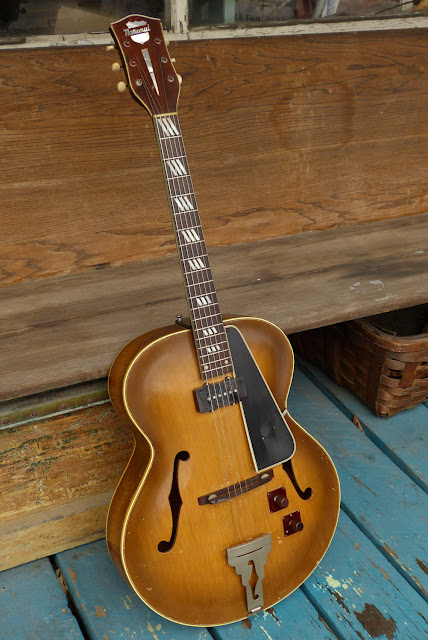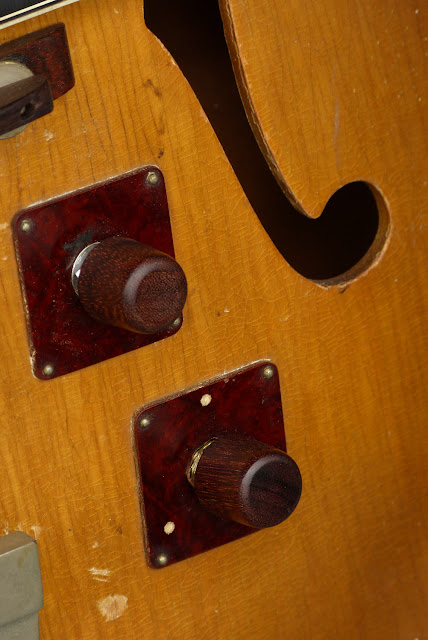1950 National 1111 Aristocrat Hollowbody Jumbo Electric Guitar
Update: Since originally posting, I've replaced the pickups and wiring harness, so I've updated the soundclip, pictures, and description.
This beastly, 17" wide bruiser is a fun new toy and has already had some band service under its belt. I've had two National archtops that I've adored and let go -- one was an electric '41 New Yorker and the other was a '50 L-48 clone -- and this blends the awesome "Stylist" bolt-on National neck that I liked on the latter with the cool, crazy-deco trim that I love from National electrics -- and then merges that with a Gibson-made ES-300 body. It not only sounds the business, it looks and feels the business, too. Later versions of this guitar used Kay-supplied bodies but the Gibson curves are more delicious, methinks, and provide that classic big band outline and a more comfortable feel in the lap.
This beastly, 17" wide bruiser is a fun new toy and has already had some band service under its belt. I've had two National archtops that I've adored and let go -- one was an electric '41 New Yorker and the other was a '50 L-48 clone -- and this blends the awesome "Stylist" bolt-on National neck that I liked on the latter with the cool, crazy-deco trim that I love from National electrics -- and then merges that with a Gibson-made ES-300 body. It not only sounds the business, it looks and feels the business, too. Later versions of this guitar used Kay-supplied bodies but the Gibson curves are more delicious, methinks, and provide that classic big band outline and a more comfortable feel in the lap.
At the time this was made, the Aristocrat was National's most high-end electric and it certainly seems posh with all the deco pearl inlay in the neck and the "iced tea" sunburst sprayed across its enormous, stage-filling body. That body is fairly thick ply throughout (with maple veneer) -- a material Gibson chose for their own hollowbody electrics at the time to cut down on feedback while at the same time making them extremely rugged.
It came to me in a mostly-original state, but minus a pickguard and with replacement knobs and jack. My work included a fret level/dress, new Seymour Duncan "hot Jazzmaster" pickup at the neck, K&K acoustic pickup installed in the body, a new wiring harness, new bridge topper/saddle, and a good setup with Thomastik flatwound 10s. I also installed the pickguard -- a nice, good quality 1930s one I've had stashed for a while and awaiting just the right guitar. The resulting guitar plays perfectly (3/32" E and 1/16" ADGBE action at the 12th fret), has a straight neck, and sounds righteous.
To me -- this is the guitar National intended to build, but missed a bit with their somewhat-dodgy original pickups (see bottom of post for a pic of those). I have the wiring harness laid-out with individual volume controls and the pickups going to a stereo jack -- the magnetic (electric) pup running to the left/mono side and the acoustic pup on the "right." I even splurged on a fancy Mogami stereo cable to keep the signals nice and clean.
That means that when one plugs in with a "normal" cable, the expected clear-sounding jazzbox electric is heard, but when one plugs-in with a stereo cable the K&K acoustic pickup can be accessed and used to get an "acoustic archtop" tone separate from the electric signal or blended with it -- or whatever! I use it to let me double-up roles on one guitar and thus get a thick, jazzy electric tone on some songs and a more honky-tonk acoustic sound on others.
To me -- this is the guitar National intended to build, but missed a bit with their somewhat-dodgy original pickups (see bottom of post for a pic of those). I have the wiring harness laid-out with individual volume controls and the pickups going to a stereo jack -- the magnetic (electric) pup running to the left/mono side and the acoustic pup on the "right." I even splurged on a fancy Mogami stereo cable to keep the signals nice and clean.
That means that when one plugs in with a "normal" cable, the expected clear-sounding jazzbox electric is heard, but when one plugs-in with a stereo cable the K&K acoustic pickup can be accessed and used to get an "acoustic archtop" tone separate from the electric signal or blended with it -- or whatever! I use it to let me double-up roles on one guitar and thus get a thick, jazzy electric tone on some songs and a more honky-tonk acoustic sound on others.
I love the misty tobacco brownburst look of this. It's totally postwar late-40s "cool" and not-quite-yet the rockabilly, atomic-age crazy that guitars would be wearing by the mid-50s.
There's copious amounts of deco pearl inlay all over the neck. The neck itself is also bound at the board and the headstock and has a slim/medium C-shaped profile with a 12" radius fretboard. This has a 24 3/4" Gibson-style scale length and a 1 11/16" nut width. The nut is bone.
The board and headstock veneer are Brazilian rosewood. The neck itself has a big central core of magnesium but the headstock and neck proper are one-piece mahogany.
The neck pickup gives a P90 look from afar, but those in-the-know will enjoy the in-joke of a Jazzmaster pickup actually on a "jazz" guitar.
The original in-bridge "acoustic" pickup was not very functional, so I made a new rosewood topper that fit on the old bridge base. It's compensated and looks the part.
The "upper" knob controls volume for the magnetic, Jazzmaster-style pickup. The "lower" knob controls volume for the K&K acoustic pickup. This lets one "turn on" or "turn off" pickups individually for different tones/roles so you can set a mix via the two outs of the stereo cable running to your mixer board or amplifiers.
The f-hole, Gibson-style tailpiece oozes class...
While the top has plain-wrap maple veneer, the back and sides have figured veneer.
The coverplates hide 1950s-style tuners of the ilk I most commonly see on Harmony products. They work, however.
I also added a vintage-style strap button at the bolt-on, adjustable neck access port.
Under that cover one finds two upper hex-adjustable bolts that adjust side-side motion on the neck, one central "lock" bolt, and one lower up/down back-angle adjuster. All works as it should and I find these gizmos very, very, very stable and practical.
Here's the old pickup assortment -- a humbucking neck pickup and an in-bridge humbucking "acoustic" pickup. They definitely "had a sound," but the bridge pickup was fussy and tended to roll forward and the neck pickup's components were rattling and the tone pretty unbalanced string-to-string -- so I decided to swap them out. They were also low-output which meant I really needed to crank my amp to get them to deliver the goods.
Still, for the time, these were very cool units.























Comments